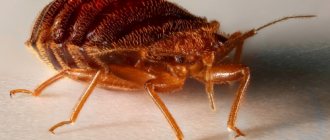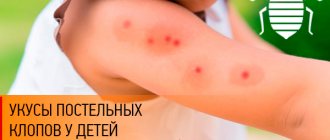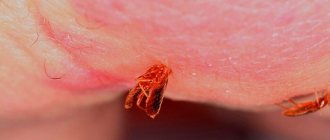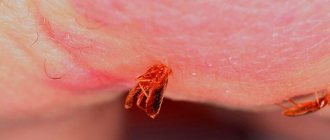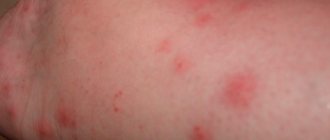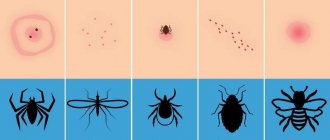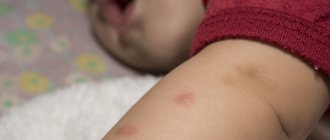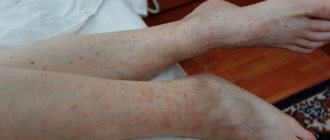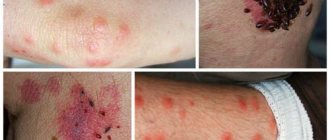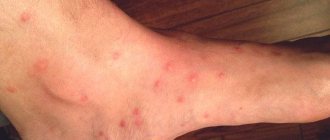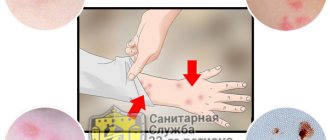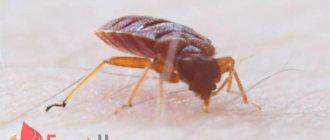How often, after a hard and boring day, a person just wants to come to his bedroom, straighten out the bed and go to bed.
But are there really no dangerous things that could disturb his peace and harm his health? Of course, there are some. And their names are bed mites, lice and bedbugs.
Such parasites can be found in feather pillows and blankets. Their bites can cause an allergic reaction in humans, which can spread to the respiratory system, gastrointestinal tract, etc.
Bed bugs
The bedbug or Cimex lectularius is a blood-sucking ectoparasite. The body length is 3-9 mm, the color is yellow-brown. It pierces the skin with the help of a special proboscis, and the jaws have 2 ducts, one of which is adapted for sucking blood, the second for releasing saliva into the wound. They bite at night from 3 to 8 am.
Features of the parasite:
The body has a strongly flattened shape, so it is difficult to crush the bug- They are nocturnal
- Up to 500 bites can be found on human skin in one night
- They bite only exposed parts of the body and are not able to bite through fabric.
- They live in upholstered and cabinet furniture, crevices, linen, clothes, under wallpaper and in books
- They live equally well both in dirt and in perfectly clean conditions.
- On a person’s clothes they are transferred to other houses and apartments
- Average life expectancy – 1 year
- Withstands temperatures up to 50 C
Harm to humans
Bedbug bites themselves are not dangerous for transmitting any diseases, although the possibility of transmission of tularemia, anthrax, brucellosis, and smallpox through the insect cannot be ruled out. Also, a bug bite does not cause pain.
But a significant skin rash, severe itching, allergies, unpleasant body odor, and unaesthetic appearance of the skin often bring psychological trauma to a person who, not knowing the cause of his condition, begins to look for terrible diseases within himself and withdraws into his problems. Thus, the consequences of a bedbug bite are physical and mental suffering for a person.
How to detect insects indoors?
- Brown-brown stains on bedding and underwear, which remain from insects accidentally crushed by humans.
- Accumulations of eggs, excrement and scales remaining after the bedbug molts in the grooves between parts of furniture, under furniture, in niches for linen of sofas and beds.
- Specific odor in the premises (in case of severe infection).
Symptoms of a bedbug bite
A person may not notice the symptoms of bedbug infestation for a long time or attribute the symptoms to other diseases (scabies, allergic dermatitis, etc.).
- Multiple small red spots on the body, resembling small pimples or mosquito bites. Traces of bed bug bites
- Slight swelling of the affected areas of the skin.
- Severe itching.
However, these symptoms are not always present. When biting, an adult bug secretes a special enzyme into the human skin, making its bite invisible both in sensation and appearance - there is no redness or itching. Vivid symptoms occur in people with a tendency to allergies, when premises are heavily infested, and also when young bedbugs bite them.
What do bed bug bites look like?
It is not difficult to distinguish bedbug bites from the bites of other insects. Typically this is:
multiple bites (50-100 or more). Although outwardly the bite sites are similar to a mosquito bite, in practice such a massive mosquito attack in a residential area is impossible;- a kind of bite path, i.e. red dots located one after the other at a distance of several mm to several cm. Unlike the passages of the scabies mite, the bedbug leaves such a path in one night, and the scabies mite - in several days.
Treatment of bedbug bites
There is no specific treatment for bedbug bites. Minor skin rashes resolve on their own within 3-4 days. Therapeutic measures are aimed at eliminating unpleasant symptoms and should be carried out in parallel with measures to combat bedbugs:
- Careful skin hygiene with detergents in the evening and morning.
- Lubricating the affected skin with hydrogen peroxide or antipruritic ointment (Fenistil) 3-4 times a day (see ointments for allergies)
- In case of a severe allergic reaction, take antihistamines for 3-5 days (Loratadine, Zyrtec, Telfast, see list of allergy pills).
How to get rid of bed bugs
The most effective is sanitary treatment of contaminated premises, which is carried out by an organization specializing in this. Very often, attempts to remove annoying insects on their own end with people simply getting rid of the infested furniture, however, this is not a guarantee that all individuals have left the living space.
Physical methods
- These include the effect of high temperature on parasites. Warming up the room for 6-8 hours at a temperature of +48 C guarantees the destruction of bedbugs and their eggs.
- At home, you can use a steam cleaner, the steam of which penetrates into hard-to-reach places, the seams of furniture upholstery, etc. This method also helps to disinfect clothes, linen, toys, etc. by heating them in dryers for about 20 minutes.
- Washing items at a temperature of at least 50 C is also effective.
Mechanical methods
This is the treatment of furniture and surfaces with a vacuum cleaner, after which the bag with parasites trapped there is destroyed. The effectiveness of the method is low due to the fact that bedbugs and their eggs may remain in places inaccessible for treatment.
Chemical methods
These include the use of insecticides, which should be used to treat furniture, cracks, baseboards, floors and other places in accordance with the instructions. The treatment should be carried out twice, the second time - two weeks after the first treatment, when young individuals can hatch from the surviving eggs.
Self-application of insecticides requires care and caution. No matter how safe insecticides are, you should not treat premises in the presence of children and pregnant women. You should strictly follow the instructions, especially the dosage of the drug, and also take personal measures to prevent poisoning.
The most effective insecticides:
GET liquid based on chlorpyrifos. Can be used in rooms where there are children. The effectiveness of the treatment provides protection against bedbugs for 6 months. The insecticide Dobrokhim Micro, which is similar in active substance, has the same properties.- Multicomponent insecticide Taran based on zetacypermethrin. The drug remains active for 2 months after treatment.
- Aerosol Raid based on cypermethrin, prallethrin and imiprothrin. Effective for 15 days.
- Boric acid, vinegar, and turpentine are also used in the fight against bedbugs, but their effectiveness is lower.
Natural Methods
These include the use of plants: tansy, fresh or dry wormwood, laid out in the most typical habitats of bedbugs - under furniture, in cracks, on the floor, etc. Treating rooms and furniture with a decoction of wild rosemary leaves also helps. These methods are safe for humans and can be used without leaving the premises.
Another natural method is to take contaminated furniture outside for several days, which is effective in sub-zero temperatures and in hot weather. Insects cannot withstand frost and direct sunlight, so they die within 24 hours. In addition, they are deprived of a power source, which accelerates their death.
They say that where cockroaches live, there are no bed bugs, since cockroaches are the latter's natural enemies. But this is not the best way to combat parasites - cockroaches, although they do not bite humans, carry various infections.
Getting rid of lice
The most common remedy for lice are various shampoos, lotions and aerosols that must be applied to the hair and the entire human body.
If the location of lice is the head, then special combs can be used as a method of combating them. As a rule, they have a very small distance between the teeth, which makes it possible to remove parasites from the hair. But this method is less effective, so it is used extremely rarely.
In order to get rid of lice that are on bed linen, you just need to wash it at a temperature above 60 degrees. In such conditions, the parasites die.
You can also simply hang your laundry outside or on the balcony. In this case, the bed lice will die on their own, since they will have nothing to eat.
Read also: Disposable sheet for massage
In order not to worry once again about how to rid your home of such neighbors, it is better to engage in prevention. It is necessary to wash your body and head thoroughly to prevent lice from appearing on them.
It is better to change bed linen at least 2 times a month and regularly clean feathers and wash covers on mattresses. This will reduce the risk of lice reappearing on the human body. In general, preventive work related to washing things must be carried out in conjunction with all methods of completely getting rid of them.
If the linen is washed thoroughly, but the lice have not been removed from the body, they will reappear in the bed.
Dust mites
Dust mites, Dermatophagoides, have microscopic dimensions of 0.1-0.5 mm. There are about 150 species of dust mites. Being a synanthropic arthropod, it lives in human dwellings. The life cycle is 60-80 days. City apartments are an ideal habitat for dust mites, since they have an optimal environment for reproduction and life activity: a temperature of 20-25 C and high humidity, plus a constant source of nutrition, which is the dead epithelium lost by humans. They are found in large quantities in house dust, beds, sofas, and carpets.
Harm to humans
These small inhabitants of city apartments do not bite humans, but cause enormous harm with their vital activity. Dust mite feces contain digestive enzymes that contribute to the destruction of human skin and, when inhaled, cause severe allergic reactions, including bronchial asthma. Tick-borne bronchial asthma is characterized by spring-autumn exacerbation and night attacks.
The most common causes of dust mite fecal antigens are atopic dermatitis, allergic rhinitis and allergic conjunctivitis.
Symptoms of tick allergy:
- persistent rhinitis not associated with ARI, which is difficult to treat with vasoconstrictors and other drugs. It begins suddenly and also ends suddenly, in advanced cases it is present almost all year round;
- nasal congestion;
- lacrimation;
- headache;
- itching and redness of the skin, dryness and flaking;
- dry cough;
- attacks of suffocation at night.
Treatment of allergies caused by dust mites
Mite allergy is a global problem, since complete destruction of house dust mites is impossible, and every year an increasing number of people are registered with increased sensitivity to dust mite antigens, especially children (the increase in children with allergies is 6% per year).
This is the most active household allergen; the number of dust mites in 10 mcg per 1 g of dust increases the likelihood of developing bronchial asthma by 3 times.
The most effective is ASID therapy: allergen-specific immunotherapy. The method involves introducing an extract of house dust mite allergens into the body in gradually increasing concentrations. Thus, the immune system gradually gets used to the allergen, the severity of the allergic reaction decreases, and overall sensitivity to this allergen decreases. Correctly carried out treatment leads to the fact that the allergic person completely stops reacting to the allergic component of the house dust mite and gets rid of symptoms.
This method is preferable to traditional treatment with antihistamines and is used in children over 5 years of age and adults. Allergies, especially to house dust mites, are difficult to correct with anti-allergenic drugs; the body gets used to them, requiring the use of increasingly stronger drugs in higher concentrations. At the same time, a person’s immunity weakens, the body becomes sensitive to new allergens, and allergic rhinitis and conjunctivitis gradually develop into asthma.
Maintaining cleanliness of the premises is of no small importance:
- carrying out daily wet cleaning
- minimizing “dust-collecting” objects: carpets, soft toys, blankets
- constant ventilation of premises
- imposing special air purifiers that supposedly clean the air, newfangled vacuum cleaners is more of an advertising ploy by the manufacturers of these products. No device can 100% get rid of dust mites. And we have no influence whatsoever on the tick infestation of public places, kindergartens, and offices.
A variety of hardening procedures, good nutrition, proper drinking regimen and a healthy lifestyle have a positive effect on the immune system and increase the body's resistance to allergens.
How to determine the presence of bedbugs?
This is quite easy to do. These parasites are most active at about 3 am. At this time, you need to set an alarm clock, after making the bed with a white sheet. By turning on the light suddenly at this time, you will not be able to help but notice bedbugs on the sheets, if there are any. There are 3 more signs of the presence of bedbugs in an apartment:
- Smell. If you smell some new aroma, then you should think about the appearance of bedbugs. Some people compare it to the smell of cheap cognac, some to sour berries.
- Bites. It is impossible not to notice bedbug bites on the body. All people react to them differently. Some people only get small spots, some get blisters, and some get a whole allergic reaction. Typically, bedbugs leave behind marks on the legs, arms, face, and neck.
- Presence of waste products of bedbugs. Usually in the space under the bed or in the sofa there are accumulations of chitinous remains of insects and their excrement.
Fleas
Fleas are small insects measuring 1-4 mm in size. The body has a flattened shape, making the insect difficult to catch. They are distinguished by great jumping ability due to the presence of long hind legs and high “maneuverability” - the flea easily runs from place to place in the animal’s thick fur
The natural hosts of fleas are warm-blooded animals with fur. A person, as an organism for constant life activity, is of no interest to a flea. Fleas that can live on a person for some time and bite him are called Pulex irritans, cat fleas, Ctenocephalus telis, can also feed on human blood. They can get into a person’s home with animals, as well as on the person himself, attached to his clothing.
Harm to humans
In addition to pain at the time of the bite and constant itching after the bite, flea bites can result in serious diseases carried by these insects: plague, dermatophiliasis, pulicosis, rat typhus, rickettsiosis, tularemia, listeriosis, dipylidiosis.
Secondary infections that occur as a result of scratching wounds result in furunculosis, abscesses, ulcers and ulcers. An allergic reaction to a flea bite leads to extensive skin irritation, which can ultimately result in neurosis and insomnia.
Flea bites on a person
Most often, fleas bite on the lower extremities. When living in blankets and upholstered furniture, fleas can bite other parts of the body. When biting, the flea firmly attaches itself to the human skin and may look like a black dot.
The symptoms of a flea bite are vivid and difficult to confuse with other types of bites. By biting, the insect injects a special enzyme into the wound that thins the blood. The bite itself is accompanied by sharp pain, which turns into itching and burning. At the site of the bite, a hyperemic spot with a diameter of about 5 mm remains, in the center of which there is a bloody dot.
The spot swells, the hemorrhagic point remains visible for 3-5 days and causes significant itching. When an allergic reaction develops, urticaria occurs.
Children may also experience general symptoms, especially with multiple bites: low-grade fever, anxiety, diarrhea.
What to do if you are bitten by fleas
- Treat the bite site with an antiseptic - hydrogen peroxide, alcohol solution, potassium permanganate.
- Apply a cold compress to the bite site.
- Apply antipruritic or antiallergic ointment to the bite area.
- During the entire period of resolution of the bite on the skin, it is important not to scratch the wound, as this will lengthen the recovery period of the skin and threaten secondary infection. Soda lotions (1 teaspoon of soda per glass of water) will help relieve itching.
- If the wound does fester, you should apply a sterile cotton swab with an antibiotic-containing ointment (levomekol, gentamicin, etc.) to the abscess.
How to get rid of fleas
- Remove fleas from pets using special insecticides.
- Disinfect animal habitats - bedding, soft houses. To do this, they need to be soaked in a solution of household disinfectant, then washed in water at a temperature of about 50 C and rinsed thoroughly.
- Treat the apartment and car interior with a special insecticide, carefully following the instructions and safety rules - Tetrix, Effective Ulra, Solfak, Chlorpirimark. If necessary, treatment is repeated after 2-3 weeks.
- If you are intolerant to chemicals, you can use the herb wormwood, which should be spread around the apartment, especially on the floor and at the entrance.
- Throw away the dust bag for the vacuum cleaner, where fleas happily live and breed.
Signs of the presence of bedbugs in the house
Parasites can be detected by a number of manifestations. As they live in the apartment, the size of the colony increases. This leads to the appearance of traces of insect activity. Empty egg shells are found, but this only happens if an old clutch has been found, which all the larvae have left. The female tries to hide the eggs well; most often the offspring are found in the nest of parasites.
As bed bugs develop, they shed their outer coverings, which have not yet fully formed and interfere with the further growth of pests. Such shells resemble husks, are brown in color, are easily blown away by the wind, and therefore can spread throughout the apartment in a draft.
Bite marks on the body
Bed bugs bite people at night. This is due to the peculiarities of their life activity. As a result, red spots are found in the morning - traces of contact with parasites. They are distinguished by external signs: size up to 1 cm in adults; in children, hyperemia manifests itself more extensively (up to 5 cm), there are usually 2-5 bites nearby, they resemble a stripe, because the parasite bites several times, moves short distances throughout the body (1-2 cm after each puncture).
The bug makes several bites per meal, often forming a straight line
Presence of a specific odor
When several bedbugs appear in a house, there are still few external signs of their presence in the room. Gradually, when the number of the colony increases to several hundreds or thousands of parasites, you can smell the old cognac. It is felt more strongly when entering a room from the street. Its appearance is due to the release of excrement by insects and other substances as they live.
The specific smell of bed bugs is a guarantee that there are insects in the apartment
The presence of small brown spots on the bed
Such signs do not appear immediately, but when the insects become more numerous and the larvae of parasites begin to bite, which are easier to crush. After eating, the insect’s body increases significantly, so the risk of injury to the bug by a person increases when he performs voluntary movements in his sleep. An adult specimen can also be damaged, but its chitinous coverings are slightly more durable than those of the larvae. If the parasite climbs onto the bed, it may not have time to hide after eating, because it crawls slowly.
If you crush a bug in a dream after feeding, but brown blood stains remain on your laundry
Black dots from bedbugs
Bed bug excrement resembles poppy seeds. They are small and black. Where nests are established, they unite, forming large spots, as they gradually accumulate as the insects live.
Black spots are bedbug excrement
Ticks
Ticks are a real threat to rural and urban residents, from warm spring days to autumn. Every year, an increasing number of infected ticks are registered, the bite of which can cause dangerous diseases such as tick-borne encephalitis, Lyme disease and others.
Ticks attack both humans and animals in order to obtain food - blood. They react to the temperature and odors of warm-blooded animals, sensing them from a distance of 5-10 meters. While waiting for prey, they sit on plants, clinging to a person’s clothing or the fur of an animal with their front paws at the moment when the animal touches the plant. They don’t bite right away, so the victim has the opportunity to notice it and shake it off.
There are about 48 thousand species of ticks in the world.
- The most real threat comes from tick bites from the order Ixodidae, which cause borreliosis and tick-borne encephalitis (symptoms),
- Arthropods that cause various tick-borne fevers.
Ticks live not only in forests and parks; they can be found in the green area of the local area, low bushes and even grass. As a rule, vegetation does not rise above 1 m. Their sizes are small, only 2-4 mm, it is very difficult to notice a tick, and it is almost impossible to feel it on yourself at the time of the attack.
Description
Despite the huge species diversity, bedbugs have similar features:
- number of limbs: adults have three pairs of limbs, they can be of different types, adapted for life on land or in water;
- oral apparatus in the form of a proboscis and bristles: the bug feeds on liquid food, it pierces the shell and sucks out the contents, be it blood or plant sap;
- glands that secrete an odorous substance that is designed to repel enemies;
- wings - most species have them, they have a certain appearance: half of the wings are leathery, the other half are membranous; There are also representatives of the family that have only elytra or have completely lost their wings as unnecessary.
Bedbugs come in different sizes - from a couple of millimeters to 15 cm. The largest representative of the family is the water bug, which grows up to 15 cm in length. The shape varies, but most of the individuals are round, with a flattened body in a chitinous shell. Round or rod-shaped forms are also found. Not all bedbugs have eyes. But the organs of touch are well developed in all varieties.
Bedbugs come in different colors. Bright colors for those who are better left alone. It is a protection and a method of intimidation. Another means of protection is a pungent, unpleasant odor, which is caused by cimicic acid. Bedbugs secrete secretions from their glands. It is this smell that animals and birds that might eat bedbugs do not like.
How does a tick bite occur?
It is almost impossible to detect a tick bite immediately. Tick bites are lubricated with a special anesthetic substance, so it is practically not noticeable. Particularly sensitive people may feel discomfort in the form of a nagging pain, a feeling as if a speck or butcher's broom had gotten under their clothes.
The tick tries to choose areas with delicate and thin skin, which is easier to bite through:
- neck;
- behind the ear area;
- armpits;
- code under the chest;
- groin and genitals;
- buttocks.
At the moment of the bite, the tick bites through the skin and places a hypostome, a special outgrowth of the pharynx with teeth that hold the tick, into the wound. In the process of sucking blood, the tick increases significantly in size.
If a tick is infected with tick-borne encephalitis, it retains the causative virus throughout its life. The virus enters the human blood through the saliva of the biting arthropod, so a person becomes infected in the first minutes after a tick bite; early removal of the parasite does not exclude infection with a dangerous infection. The same applies to tick-borne fevers.
If a tick is infected with borreliosis, the pathogenic bacteria enter the human blood only when the tick begins to suck blood, because live in the gastrointestinal tract of arthropods, and this is a few hours after the bite. In this case, early tick removal can prevent disease.
The main differences between ticks and bedbugs
From a distance, bedbugs and ticks are very similar. But if you look closely, you can see that the representative of the Arachnida class has eight legs, while bedbugs have six.
Bed mites have impressive dimensions and can be up to 8 mm in size. Their cousins, dust mites, are quite difficult to detect due to their small size. Furniture bugs are nocturnal bloodsuckers, while linen mites feed on dead skin particles.
Bed bugs live in secluded dark places in the apartment. They can be found in furniture, under baseboards and wallpaper, in old things. House mites live in feather blankets, pillows, and blankets.
How to properly remove a tick - first aid for a tick bite
If it is possible to get to a medical facility as soon as possible, this should be done; doctors will quickly and without consequences remove the tick. If this is not possible, you should remove the tick yourself as quickly as possible:
Put rubber gloves on your hands and a plastic bag. Remove the tick:
- using special devices (Tick Twister, Ticked-Off, The Tickkey, Trix Tick Lasso, Anti-tick). They are always accompanied by detailed instructions for use.
- using thread. A strong thread is draped over the tick's head at the very base, i.e. near the skin in the form of a loop. The ends of the thread are carefully tightened, after which, holding the ends of the thread, you should rotate the tick clockwise or counterclockwise - a couple of movements, and the tick can be easily removed from the wound.
- using tweezers. Using the tip of tweezers, carefully grasp the head of the tick and twist it without pressing on the abdomen or tugging.
After removing the tick, place it in a glass jar.
- Remove tick remains with a sterile needle if they remain in the wound. It is best to use a sterile needle from a new syringe; in extreme cases, you can take a regular needle, hold it over the flame, treat it with alcohol a minute after it has cooled, and only then remove the tick.
- Treat the wound with an antiseptic.
- Send the extracted tick to the laboratory for testing.
Fighting methods
If parasites have recently begun to appear, you can try to get rid of them on your own. Like clothes mites, bedbugs die at high temperatures from +50 or at low temperatures from -20 . For example, treat contaminated items and places with hot steam or freeze a room in the cold season.
Often, folk methods mention getting rid of parasites using strong-smelling herbs such as wormwood or tansy.
Today there are many chemicals on the market for pest control (bedbugs, ticks, fleas, etc.). If the infestation area is large, you should contact special insect extermination companies. Only professional help can guarantee quick and complete cleansing of your home.
Consequences of an encephalitis tick bite - symptoms of tick-borne encephalitis
The latent period is 5-25 days, but most often symptoms appear in the period 7-14 days after the tick bite. The general symptoms characteristic of this infection begin acutely and vividly, i.e. The patient can clearly indicate the start time of the clinic:
- heat;
- chills;
- Pain in the eyes;
- photophobia;
- pain in muscles, bones and joints;
- headache;
- vomit;
- lethargy and drowsiness;
- seizures (in children);
- redness of the sclera of the eyes, skin of the face, neck, upper body.
Forms of encephalitis
The target organ of the disease is the brain (see statistics on tick-borne encephalitis). There are several forms of encephalitis, which have their own clinical characteristics.
- Feverish form
Diagnosed in 40-50% of cases. Fever, the main symptom of the disease, lasts 5-6 days at a level of 38-40 C. After the temperature drops, the main symptoms disappear, but weakness and lethargy remain for several more weeks. Complications occur very rarely.
- Meningeal form
This is 50-60% of cases. It occurs with severe general intoxication (hyperthermia over 38 C, fever, chills, sweating, high-intensity headache), as well as symptoms of inflammation of the meninges: nausea and vomiting, decreased elasticity of the occipital and neck muscles (difficulty when trying to bring the chin to the neck), facial asymmetry, dilated pupils. Recovery is long, remission occurs in a state of weakness and weakness. Chronitization of the process is possible.
- Focal form
The heaviest downstream. Characteristics: high temperature, impaired consciousness with delusions and hallucinations, severe intoxication, convulsions, disorientation in space, impaired breathing and heart function. Most often it becomes chronic.
- Chronic form
Develops over several months and even years after the disease. Frequency - 1-3% of cases of the total number of cases. The patient experiences constant twitching of the muscles of the neck, shoulder girdle and face, tendon reflexes and muscle tone in the limbs decrease, the psyche is disturbed, and dementia develops.
Life cycle of bedbugs from larva to adult
The intensity of parasite growth depends on environmental conditions. The development of bedbugs occurs within 30-55 days. Under favorable conditions, parasites develop within 1 month. The more the temperature and humidity in the room deviate from normal values, the longer it takes the insects to develop.
It must be taken into account that the life cycle of bed bugs is divided into several stages. Parasites skip the pupal stage. The eggs immediately hatch into larvae, which later develop into adult insects.
Bed bug life cycle diagram
Pairing
If you are studying the question of how a bedbug reproduces, you should know that for the female this process threatens death, because during mating the male pierces the abdominal cavity with an appendage, which is located at the end of the abdomen. In this case, the organ does not penetrate the reproductive tract of females. As a result, the probability of death of the insect increases, since bacteria enter the abdominal cavity along with the appendage. To prevent infection, the female has a Berlese organ.
Inside there are immune cells that, upon contact with bacteria, begin to destroy the cell membranes of the latter. This organ resembles a small pouch. It is practically invisible from the outside, only a depression on the surface of the abdominal cavity is noticeable. The seminal fluid goes directly into this sac. For a female to reproduce, a single traumatic insemination is enough (this is what sexual contact between parasites is called).
This is due to the lack of ability to distinguish between the characteristics of a sexual partner. Insects protect themselves from attack by secreting substances that repel an overly active male with their scent.
The mating process of bed bugs.
A male bedbug pierces the abdomen of a female. The male's seminal fluid enters a special organ in the abdomen of the female.
Eggs
At the initial stage of the life cycle of development, the larva is formed inside a protective shell. In 1 day, the female can lay up to 5 eggs. Under favorable conditions, one clutch can contain 10 eggs, but this rarely happens. Much more often the female lays 3-4 eggs. Parasites can reproduce without interruption. They lay eggs every day every month for a year.
The offspring at this stage looks inconspicuous. Small formations are characterized by white color and reach 1 mm (length). The incubation period of the bedbug at the first stage lasts 5-14 days. Under normal conditions, offspring are formed inside the eggs for up to 7 days. If environmental parameters change, the incubation period increases. The parasites inside are well protected from external factors.
Bright light eggs are clearly visible on the felt
Nymphs - larvae
The life cycle of a bedbug is divided into several stages of development of young individuals. The larvae are similar in appearance to adult insects. Note the similarity of the shape and structure of the body. However, the size and color of the parasite at the initial stage of development is significantly different.
The size of the larva varies from 1 to 5 mm. Growing bedbugs have several stages of development. During this period, the young insect sheds its chitinous covers 4 times. This happens once every 5-6 days.
This need is due to the fact that the parasites grow, and the shell is inelastic and does not grow with the insect. The larvae immediately begin to feed as soon as they leave the egg shell.
One bedbug hatches from one egg
Adults
Bed bugs reach sexual maturity fairly quickly. The average body length is 6-8 mm. Moreover, males are smaller than females. When the larva passes the last stage of development, it enters the next phase - the adult, and immediately begins to reproduce. The body color of such insects is dark brown.
The nymph of the last stage of the bed bug sheds its chitinous covering and becomes an adult.
Borreliosis
This disease occurs with damage to the nervous system, joints, heart, skin, and very often becomes chronic. 10-14 days after the bite, the early stage of the disease begins:
| General symptoms | Specific symptoms |
|
|
Stage of spread of infection (2-3 weeks - 2-3 months after the bite)
| Nervous system | Lumbar pain, facial pain along the nerves due to their inflammation. Decreased memory, impaired thinking processes |
| Heart | Pericarditis, myocarditis, arrhythmia |
| Leather | Transient red rash. Nodular and tumor-like elements |
| Eyes | Iritis, conjunctivitis |
| Respiratory system | Tracheitis, bronchitis |
| Joints | Arthritis and polyarthritis |
What types of ticks carry encephalitis?
Nature is not only a great place to relax and a source of inspiration. It is there that we face great danger in the form of small blood-sucking parasites. They can be found everywhere: in the grass and on the leaves.
Ixodid ticks (Ixodidae) are carriers of the causative agent of tick-borne encephalitis, a disease that mainly affects nerve cells in the human body. These may be brain structures, peripheral innervation, or radicular nerve endings in the spinal cord. Science knows about 650 species of these arachnids. In our latitudes, two species pose the greatest danger: taiga and dog.
The encephalitis tick is a carrier of a dangerous and currently incurable viral disease
Taiga tick
A small spider from 4 to 6 mm, belonging to the order Arthropods. Most often it can be found in the forests of Siberia, the Urals, and the Far East. Due to the fact that over the last century there has been a sharp warming of the climate, the usual habitat of the taiga tick has expanded. Today it can increasingly be found in Belarus, the Baltic countries and south-eastern France. Taiga ticks are carriers of Lyme disease and tick-borne encephalitis.
In Russia, the taiga tick is one of two species that transmit the encephalitis virus
Dog tick
This type of tick is widespread in the European part of Russia, as well as in the countries of Central and Northern Europe. At the end of spring and beginning of summer there is a peak in the number of their bites. The dog tick is similar to a taiga representative of the family, and by external signs it is almost impossible to distinguish them from each other. Today it is quite often found in summer cottages and garden plots, at camp sites, and in places where dogs are kept. A humid microclimate and the presence of a host are the main conditions for survival.
Dog ticks pose a danger not only to animals, but also to people.
Ticks are the main carriers of viral encephalitis. But you cannot judge by the appearance of a tick whether it is infected or not. This can only be detected in laboratory conditions. The source of the disease is both the bloodsucker itself and its larvae. The cause of tick infection can be considered to be its previous activity on a sick animal.
How do Ixodid ticks reproduce?
The female tick lays about 15 thousand eggs after drinking blood. But not everyone will reach the adult stage; this largely depends on natural conditions. The end result is usually only a few dozen individuals. The clutch matures within a few weeks.
The larva feeds once. Small warm-blooded animals become her victims, since it is difficult for her to get to the top. The feeding process can last for 2–3 days, and then the larva becomes a nymph (an adult without sexual maturity). The individual spends the winter in this state. With the onset of spring, the nymph is ready to hunt, and larger animals become its victims. In this state, it matures to the imago stage (adult sexually mature individual) within a year. Unlike females, sexually mature males need from 30 minutes to several hours of preliminary saturation to be able to mate.
Crimean hemorrhagic fever
A severe viral disease transmitted through the bites of ticks of the genus Hyaloma. The disease is widespread in the Astrakhan, Rostov and Volgograd regions, Krasnodar and Stavropol territories, Volgograd regions, Dagestan, Kalmykia, Central Asia, China, southern Ukraine, and Crimea.
Symptoms of the disease
- Occurs within 2-14 days after the bite.
- The initial period lasts 3-4 days: severe hyperemia, intense headache, body aches, especially in the lower back, severe weakness, vomiting, lack of appetite, dizziness, impaired consciousness.
- During the peak period, there is an abrupt decrease in t - first it drops for 1-1.5 days, then it rises and lasts up to 7 days, after which it falls again. There is a petechial rash on the chest and sides of the abdomen, bleeding gums, bleeding from the ears and eyes, internal organs, and nose. The condition worsens sharply, blood pressure drops, tachycardia, lethargy, and confusion occur. The mortality rate reaches 25%.
- During the recovery period, which lasts from several months to 1-2 years, a person feels weakness and fatigue, heart pain, dizziness and headaches, and a decrease in blood pressure.
What not to do if you are bitten by a tick
- Panic. Absurd actions in such a situation are definitely not necessary. Remember - not every tick is contagious, but it’s too early to relax.
- Removing a tick from the skin with bare hands means there is a risk of the virus entering the body through micro-cuts in the skin.
- Touch eyes and mucous membranes with hands that touched the tick.
- Use oil and other liquids to deprive the tick of oxygen - in this case, the aggressiveness of the tick increases.
- Squeezing or sharply pulling out the tick will allow saliva and gastric contents to enter the wound. A sharp pull out of the tick threatens to rupture it - part of the arthropod will remain in the body.
Mole
This seemingly unremarkable moth is able to climb deep into closets and lay eggs on clothes made of woolen fabrics and fur. The hatched larvae happily eat wool and fur collars, hats and shoe linings. And some types of moths prefer to eat food, so larvae can be found in old cereal, in a bag of crackers or dried fruit.
How to get rid
Everyone has seen moth guards in childhood, which mother or grandmother hung on the same hanger with fur coats. However, as it turned out, this remedy only repels moths, but does not kill them.
You can kill moths literally in one day using insecticidal aerosols. However, some sprays have an unpleasant odor and a high price.
Photo: TASS/CM Bahr/picture alliance/Arco Images G
Disease Prevention
It is prescribed after examining the extracted tick if it turns out to be infectious.
- Borreliosis is a course of antibiotic therapy, depending on the drug, carried out for 5-20 days after the bite.
- Tick-borne encephalitis is the administration of immunoglobulin obtained from the blood of a person who has recovered from the disease. Very often causes serious allergic reactions. In Europe, immunoglobulin is not used; antiviral treatment is prescribed (yodantipyrine for adults, anaferon for children).
Furniture bug - a small home bloodsucker
Owners of apartments infested with parasites are interested in whether furniture bugs and bed bugs are different? In fact, this is one species that neighbors humans, regardless of the sanitary condition of the home. Its representatives feed not on leftover food, but on blood. Uninvited guests prefer to settle in the crevices of furniture located close to the sleeping place; their name is associated with this feature.
It is difficult to detect them, since the size of a hungry insect is 3 mm. When it begins to feed, the body increases and after 12 minutes its length reaches 8 mm. Itchy sores remain at the site of the bites, causing a lot of trouble. In a room with a large number of colonies, you can forget about a good night's rest.
Preventing tick bites
- Wear thick clothes in light colors when visiting forests and parks. Clothing should fit tightly to the wrists and ankles. Tuck your pants into your boots.
- Wear a thick hat.
- Use special repellents that are applied to clothing or skin: Defi-taiga, Off, Ftalar, etc.
- Avoid walking past tall grass and bushes.
- After visiting the forest, carefully examine each other, as well as the animals that were with you. If the forest walk is long, check each other out after an hour, using light clearings with a minimum of vegetation. Pay special attention to the tick's favorite parts of the body.
- Do not bring freshly cut grass or branches into the house - there may be ticks there.
- People professionally associated with frequent visits to forests are vaccinated against tick-borne encephalitis.
- When going to the forest, take with you everything you need that may be useful when biting a tick. Special kits have been developed: Anti-mite module.
Author:
Sabuk Tatyana Leonidovna hygienist, epidemiologist
Chemicals
In 90% of cases, owners use chemical insecticides.
- “Executioner” dissolves in water before use, and it must be applied in a draft-free room (the main component does not withstand exposure to fresh air).
- “Mashenka” comes in the form of a pencil, which is applied to the places where colonies are supposed to have settled.
- “Fufanon” will get rid of the problem in a day, but it must be used with caution - the use of a mask and gloves will become an indispensable condition, and people and animals will have to leave the room.
- "Karbofos" is even used to eliminate garden pests, but it is not environmentally friendly.
- “Insecticide” is economical and effective, and 1 bottle of spray is enough even to treat a 3-room apartment.
